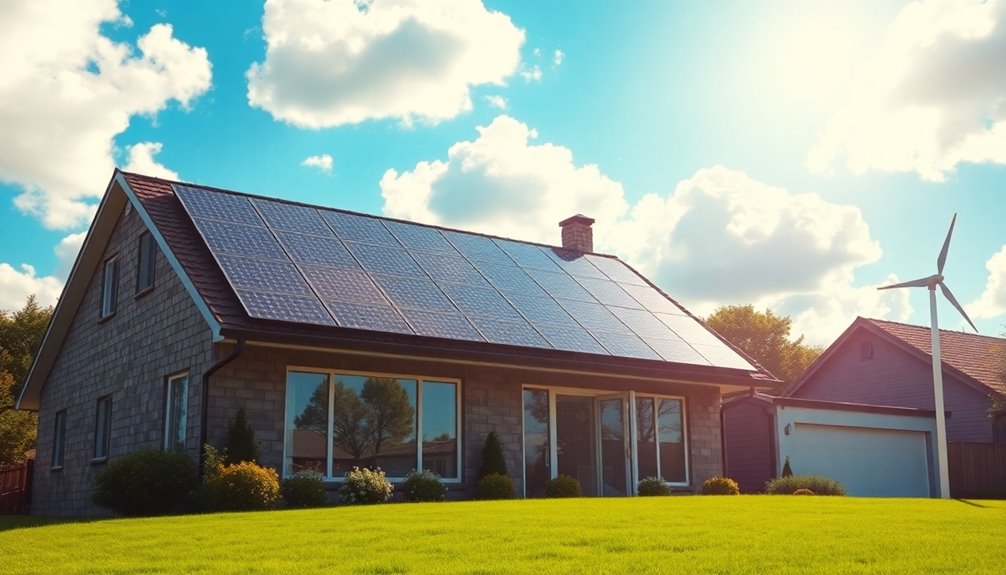Yes, switching to renewable energy sources at home can be cheaper for you. You could save around $500 annually on energy costs. Solar and wind energy are now very competitive, with prices dropping considerably in recent years. There are also federal tax credits available to lower your initial investment. Plus, clean energy installations can boost your property value. While the upfront costs might seem intimidating, the long-term savings and benefits often outweigh them. Curious about how to optimize your switch and maximize savings? There's more information available to guide you through the process.
Cost Comparison of Energy Sources
When you stack up the costs of different energy sources, renewable options often shine brighter than fossil fuels. A cost comparison reveals that onshore wind energy costs about $44 per megawatt-hour, while solar power sits at around $50 per megawatt-hour. In contrast, fossil fuels can range from $0.05 to $0.17 per kWh, making renewables competitive.
Hydropower has consistently proven cheaper than fossil fuels, with costs estimated around $0.05 per kWh between 2010 and 2018. By investing in renewable energy, you not only save money but also contribute to sustainable practices that benefit the environment. Additionally, choosing renewable energy aligns with ethical fashion choices that promote sustainability in various industries.
While it's true that initial costs for renewable energy sources can be high, they come with significant long-term savings. Once installed, you won't face fuel costs, and operation and maintenance expenses are lower over time.
Investing in renewables can save your household approximately $500 annually, showcasing the financial benefits of making the change.
Moreover, the Levelized Cost of Energy (LCOE) indicates that new solar and wind projects are often more affordable than maintaining existing coal-fired plants. This emphasizes the economic advantages of shifting to renewable energy, ultimately making it a smart choice for your wallet and the environment.
Additionally, tracking your energy expenses can enhance your overall financial health and help you identify potential savings through effective monitoring.
Financial Impact of Clean Energy
Clean energy can greatly boost your household finances, offering savings that add up over time. By switching to a clean energy supplier, you can considerably reduce household energy costs.
Here are some key ways you can save:
- Annual Savings: Households can save an average of $500 annually through reduced energy costs and operational savings, and using budgeting tools can help you allocate these savings effectively. Additionally, utilizing automated savings apps can optimize your financial management.
- Efficient Heating: Over 100 million households could save hundreds of dollars monthly by adopting electric heat pumps, which are more efficient than traditional heating methods.
- Affordable Projects: The cost of new solar and wind projects is now more affordable than fossil fuel alternatives, making the shift financially advantageous.
- Electric Vehicles: If you switch to electric vehicles (EVs), you could achieve cost savings of less than half per mile compared to gasoline cars, enhancing your overall cost efficiency.
- Additionally, incorporating sustainable and ethical shopping practices can further maximize your savings while supporting a clean energy economy.
Long-Term Savings From Renewables
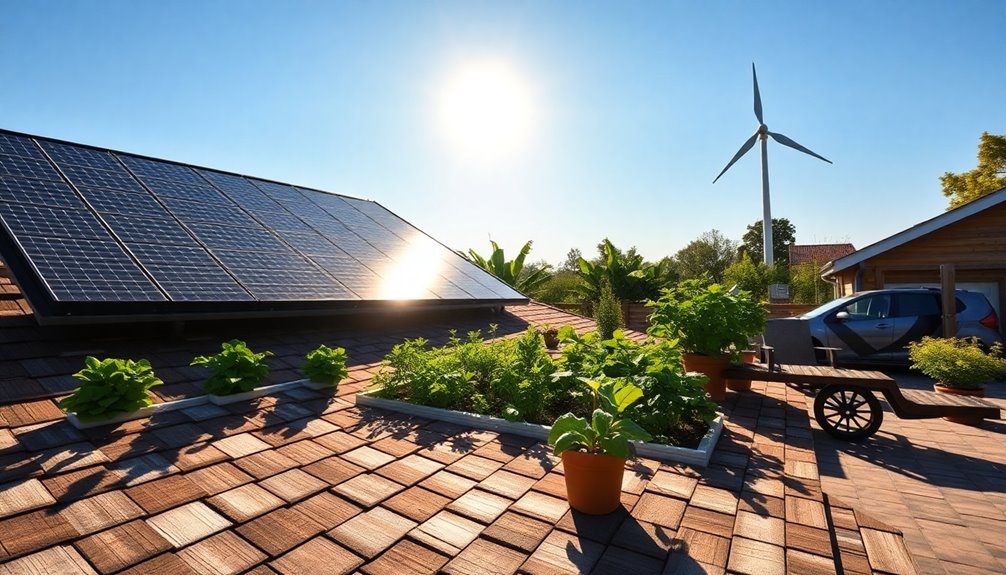
Investing in renewable energy sources can lead to substantial long-term savings for your household. By switching to options like solar panels or wind energy, you could save an average of $500 annually due to lower operating costs compared to fossil fuels. The cost of installing solar panels has dropped over 55% in the last five years, making it easier to reap those long-term savings. Additionally, if you replace traditional heating systems with electric heat pumps, you might see annual savings of up to $1,330. This significant cost advantage adds to the appeal of renewable energy, as it encourages disciplined savings habits through specific goals. If you consider electric vehicles (EVs), they not only provide lower maintenance costs but also cheaper charging compared to gasoline cars. While the upfront cost of many EV models hovers around $30,000 before tax credits, the long-term financial benefits can be considerable. Moreover, investing in clean energy boosts your property value, thanks to energy-efficient upgrades. Furthermore, utilizing expense tracking tools can help you manage the initial investment and ongoing savings from these renewable energy sources effectively. In addition, adopting expense management apps can streamline the process of tracking your investments and savings over time.
Initial Investment Considerations
When considering renewable energy for your home, you'll need to evaluate the upfront costs and potential long-term savings.
With various financing and incentives available, like federal tax credits and leasing options, the initial investment can become more manageable. Utilizing budgeting apps can help track expenses related to this transition and ensure you're making the most of your financial resources. Additionally, these tools can provide insights into your spending habits, promoting financial awareness as you navigate your energy choices. Moreover, many of these apps offer real-time insights into your finances, making it easier to monitor your investment in renewable energy.
Understanding these factors will help you make an informed decision about shifting to greener energy sources.
Upfront Cost Analysis
Steering through the upfront costs of renewable energy sources can feel intimidating, but understanding your options makes it manageable.
Here's what you need to take into account when evaluating the initial investment in renewable energy, especially solar panels:
- Cost of Solar Panels: Prices have dropped by about 90% since 2011, making solar panels more accessible.
- Monthly Payments: The average added cost for green power in 2016 was around $16.25 per month, which can be offset by savings on energy bills.
- Tax Credits: You can take advantage of federal tax credits, like the 26% incentive, to greatly reduce upfront costs.
- Leasing Options: If an outright purchase feels intimidating, leasing solar panels offers lower monthly rates compared to traditional electricity, easing the initial investment burden.
While the upfront cost might seem high, these factors can help you make a more informed decision.
Long-term Savings Potential
Switching to renewable energy not only helps the environment but can also lead to considerable long-term savings for your household. By investing in clean energy systems like solar panels, you can dramatically reduce your energy bills. Since 2011, the costs of these installations have dropped by about 90%, making them much more accessible.
On average, households that adopt renewable energy can save around $500 annually, which helps offset the initial installation costs over time. Additionally, the average added cost for green power was only about $16.25 per month in 2016, a manageable increase when you consider the long-term savings.
Moving to electric heat pumps can further enhance your savings, potentially cutting your heating bills by up to £1,330 each year compared to traditional electric storage heaters.
Moreover, federal tax credits, like the 26% incentive for solar installations, greatly lower your initial costs, making it easier to switch to renewable energy.
Ultimately, the change to clean energy represents not just an eco-friendly choice but a smart financial decision that pays off in the long run.
Financing and Incentives Options
Investing in renewable energy can seem intimidating due to the initial costs, but various financing and incentive options can make the process much more manageable.
With the price of solar panels dropping by about 90% since 2011, you're in a great position to explore these options.
Here are four ways you can ease the upfront costs:
- Federal Tax Credit: You can take advantage of a 26% tax incentive for solar panel installations, providing significant financial support to offset your upfront costs.
- Leasing Options: Instead of buying solar panels outright, consider leasing. This allows you to enjoy lower monthly rates compared to traditional electricity bills without a hefty initial investment.
- State and Local Incentives: Many local and state governments offer additional grants and rebates to encourage the adoption of renewable energy, further reducing your initial expenses.
- Electric Vehicle (EV) Incentives: If you're considering an EV, you can benefit from tax credits that help manage those initial costs.
Trends in Renewable Energy Costs
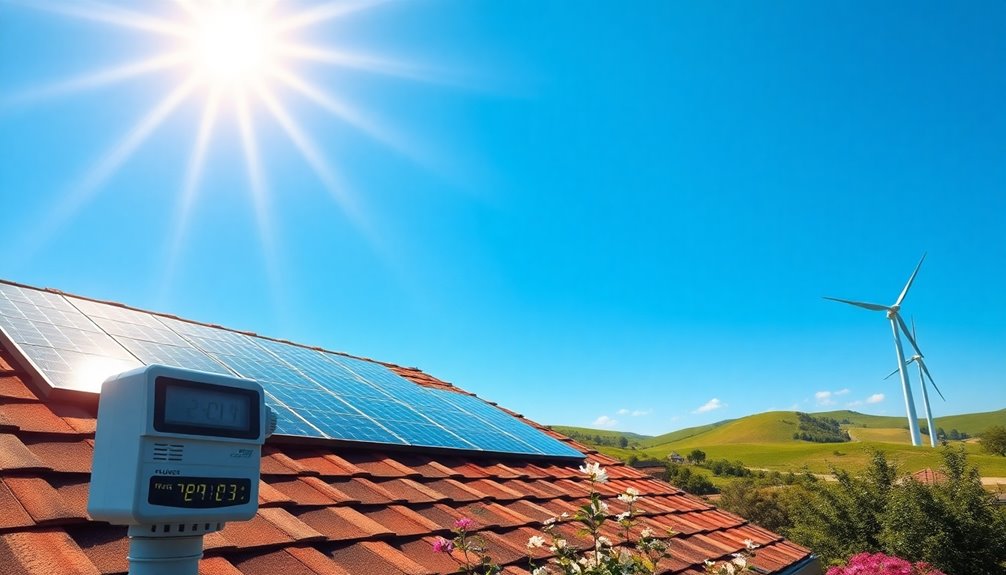
The landscape of renewable energy costs is evolving rapidly, making sustainable options more accessible than ever. Installation costs for renewable energy technologies have dropped substantially over the years, with solar power seeing a remarkable decrease of over 55% in just the last five years. Additionally, tools like budget management software can help you effectively manage the initial investment in renewable energy systems. YNAB is a popular budgeting tool that can assist in allocating funds towards this transition.
This trend reflects increasing demand, which has driven prices down, creating a more attractive market for consumers like you.
Government subsidies play an essential role in lowering these costs, making shifting to renewable energy not just a responsible choice, but also a financially sound one. For many households, investing in renewables can save around $500 annually, highlighting the long-term financial benefits that come with embracing solar power and wind energy.
Technological advancements in wind energy are further enhancing its competitiveness against fossil fuels, leading to continued cost reductions. By utilizing personal finance tools to track your investments in renewable energy, you can maximize the benefits of your financial decisions.
As these trends unfold, you'll find that renewable energy isn't just an environmentally friendly option—it's becoming a smart financial decision. By making the switch now, you can take advantage of these lower costs and set yourself up for significant savings in the future.
Environmental Benefits of Renewable Energy
With renewable energy becoming more affordable, it's important to recognize the significant environmental benefits these sources bring. By switching to renewable power, you can't only save money but also contribute to a healthier planet.
Here are four key benefits:
- Reduced Air Pollution: Renewable energy sources produce little to no greenhouse gas emissions, helping to minimize air pollution and combat climate change.
- Lower Carbon Footprint: Adapting to clean electricity allows you to reduce your carbon footprint, making a positive impact on the environment.
- Improved Public Health: By decreasing air and water pollution, renewable energy can lead to fewer health issues and lower healthcare costs, benefiting your community.
- Enhanced Energy Security: Utilizing renewable energy enhances energy security by reducing dependency on imported fuels, creating a more stable energy landscape.
When you embrace renewable energy, you're not just choosing a cost-effective solution; you're also making a commitment to a sustainable future.
The change to renewable power supports economic resilience while promoting cleaner air and a healthier environment for everyone.
Transitioning to Clean Energy
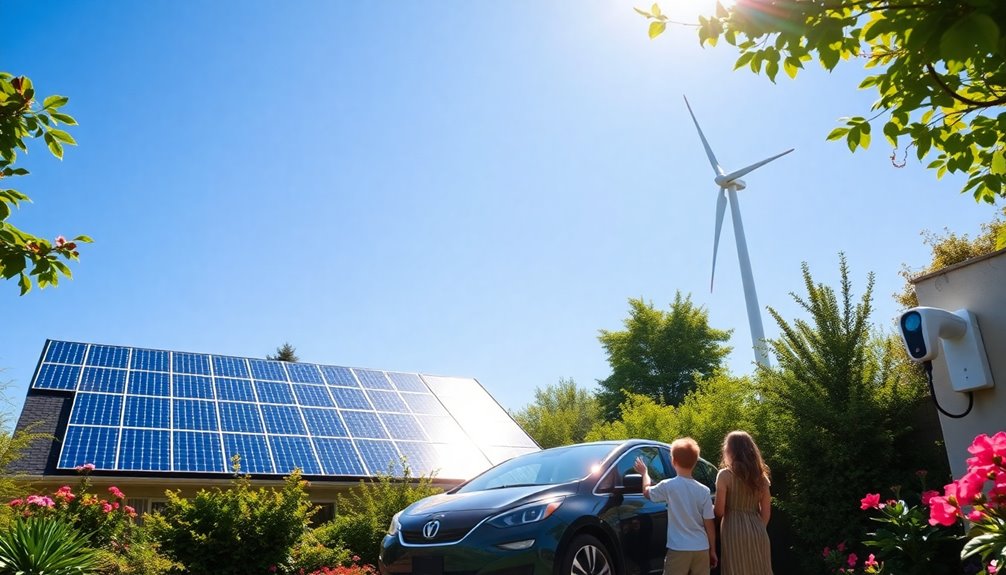
Shifting to clean energy not only helps the environment but can also save you money.
With lower operational costs and government incentives, making the switch is more affordable than ever.
In this section, we'll explore the financial benefits and the installation process to help you get started.
Financial Benefits Overview
Investing in clean energy sources not only reduces your carbon footprint but also offers significant financial benefits. By shifting to renewable energy, you can enjoy various savings and incentives that make this switch worthwhile.
Here are four key financial benefits of adopting clean energy solutions:
- Annual Savings: Households can save an average of $500 annually due to reduced energy costs and less reliance on fluctuating fossil fuel prices.
- Affordable Solar Panels: The cost of solar panel installation has dropped by about 90% since 2011, making it more accessible for you to invest in renewable energy.
- Electric Vehicle Savings: Utilizing electric vehicles (EVs) can cut your fuel costs to less than half per mile compared to traditional gasoline cars, enhancing your overall savings.
- Tax Incentives: Take advantage of financial incentives like the 26% federal tax credit for solar panel installations, which boosts the financial viability of your shift to clean energy.
Long-term, the savings from adopting these technologies often outweigh the initial investment, providing you with substantial financial benefits while contributing to a sustainable future.
Installation Process Explained
Shifting to renewable energy doesn't just bring financial benefits; it also involves a straightforward installation process that can be easily managed. When you decide to go solar, you'll typically begin by evaluating your energy needs and selecting the right system, like solar panels or heat pumps.
With the cost of solar panels dropping by around 90% since 2011, this change is more affordable than ever. Utility companies often handle the installation process for you, ensuring that your service continues without interruptions.
Plus, many homeowners can tap into government incentives, such as federal tax credits of 26%, greatly reducing upfront costs. This means you can install clean energy systems with less financial burden.
Once your solar panels are up and running, you'll enjoy no fuel costs and lower operational expenses, leading to long-term savings on your energy bills. If upfront costs still feel intimidating, consider leasing options for your solar installation.
These typically offer lower monthly rates compared to traditional electricity, making the switch to clean energy not just viable, but financially smart. Overall, the installation process isn't just about setting up new systems; it's a step toward a sustainable future.
Electric Vehicles and Cost Savings
Electric vehicles (EVs) are becoming a smart choice for budget-conscious households looking to cut down on transportation costs.
If you're considering making the switch, here are some key cost-saving benefits:
- Lower Operating Costs: EVs typically cost less than half per mile to operate compared to traditional gasoline cars, leading to significant savings over time.
- Affordable Models: Many EV models are priced around $30,000 before tax credits, making them increasingly accessible for most consumers.
- Reduced Maintenance Costs: With fewer moving parts and no need for oil changes, EVs have lower maintenance costs, which can save you even more in the long run.
- Cheaper Charging Options: Charging your EV at home can be more economical than buying gasoline, especially if you use solar energy or take advantage of off-peak electricity rates.
Home Energy Efficiency Improvements
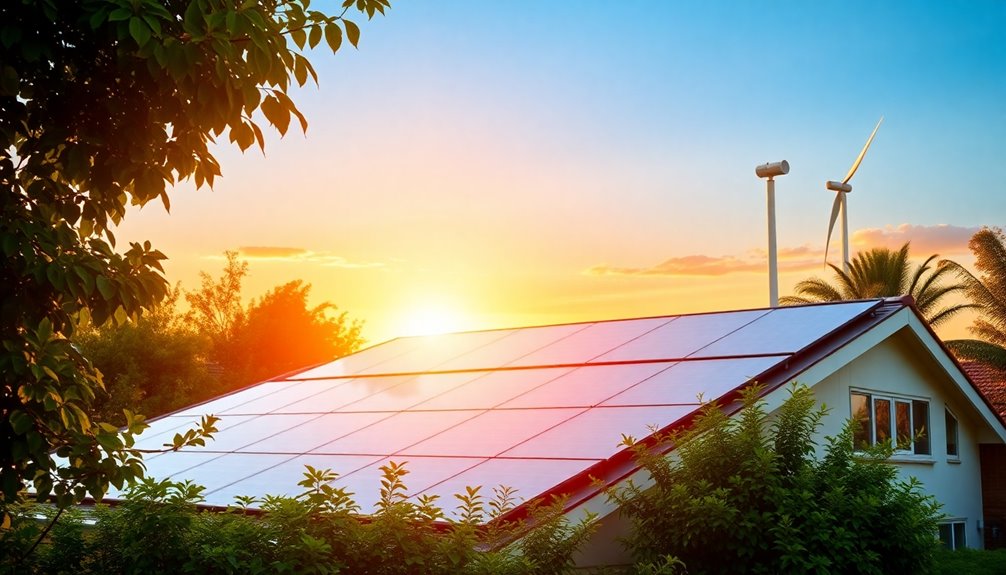
Improving your home's energy efficiency can lead to significant savings on utility bills while also benefiting the environment. One of the most effective upgrades you can make is switching to electric heat pumps, which can save you up to £1,330 annually compared to traditional electric storage heaters.
Additionally, installing dual-pane windows and enhancing insulation can dramatically reduce your heating and cooling costs over time.
Consider investing in smart thermostats, too. These devices can optimize your heating and cooling schedules, potentially lowering your energy bills by 10-15% each year.
Another easy way to boost energy efficiency is by switching to energy-efficient appliances. These appliances consume much less electricity than standard models, leading to substantial savings.
If you're looking for DIY solutions, think about installing solar panels or small wind turbines. These clean energy systems can provide long-term savings on your electricity bills and decrease your reliance on the grid.
Government Incentives and Support
Government incentives can make your switch to renewable energy much more affordable.
You can take advantage of federal tax credits, local incentive programs, and grants specifically designed for households.
These financial supports help reduce the upfront costs, making green energy solutions a viable option for you.
Federal Tax Credits
Taking advantage of federal tax credits can make a remarkable difference in the cost of installing renewable energy systems at home.
One of the most appealing financial incentives is the Investment Tax Credit (ITC), which allows you to deduct 26% of the cost of your solar energy system from your federal taxes, considerably lowering your upfront expenses.
Here are some key benefits you should consider:
- Tax Credit for Solar Energy: Install solar panels and enjoy a 26% tax credit, available for systems installed before the end of 2022.
- Electric Vehicle Incentives: You can save up to $7,500 on electric vehicle purchases, depending on the model and battery capacity.
- Grants and Rebates: The federal government offers grants for energy-efficient home upgrades, like electric heat pumps, which lead to long-term savings.
- Complementary Incentives: Local and state programs may further enhance the benefits of federal tax credits, boosting your savings on renewable energy sources.
Local Incentive Programs
Local incentive programs can greatly enhance your ability to harness renewable energy at home. Many local governments offer financial incentives, like tax credits and rebates, specifically designed to reduce the upfront costs of installing renewable energy systems.
For instance, when you install solar panels, you could take advantage of the federal tax credit of 26%, leading to significant savings.
Additionally, some utility companies run incentive programs that provide rebates for energy-efficient upgrades, such as electric heat pumps and energy-efficient appliances. These programs not only help you save money but also encourage you to make your home more sustainable.
If you're unable to install solar panels on your property, community solar programs are a fantastic option. They allow you to benefit from shared solar projects, often at a lower cost compared to traditional energy sources.
By participating in these local incentive programs, you can make renewable energy more accessible and affordable, paving the way for a greener future in your home.
Don't miss out on these opportunities to lower your energy bills while contributing to a more sustainable environment.
Grants for Households
When it comes to making your home more energy-efficient, grants for households can play an essential role in easing the financial burden.
These grants are designed to support the shift to renewable energy, helping you reduce installation costs and make greener choices.
Here are some key grants and incentives you might consider:
- UK Government Grants: Up to £5,000 for households installing air source heat pumps, making renewable heating more affordable.
- U.S. Federal Tax Credits: A 26% reduction on solar panel installation costs, greatly lowering your upfront investment.
- Local Incentives: Many states offer additional rebates and financial assistance programs for solar, wind, and electric vehicle (EV) charging installations.
- Community Energy Schemes: These initiatives often provide financial support or subsidies for collective renewable energy projects, helping households save on overall installation costs.
The Role of Community Engagement
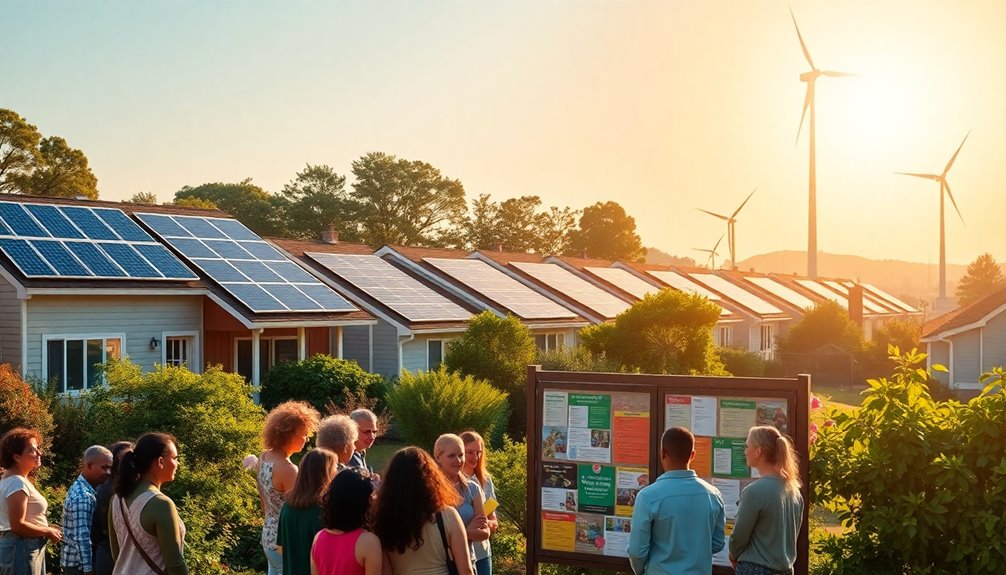
Community engagement plays an essential role in the success of renewable energy projects, altering how neighborhoods approach sustainable living. When you get involved with local initiatives, you can tap into collective purchasing power, greatly lowering your utility bills.
By collaborating with neighbors on renewable energy solutions, you're not just reducing costs; you're also fostering local investment that enhances community resilience and supports local economies.
Participating in community energy schemes promotes awareness of energy-efficient practices, helping everyone understand their energy consumption better. This knowledge empowers you to make informed decisions, leading to further cost reductions.
The more your community promotes renewable energy options, the higher the overall participation will be, driving down costs for everyone involved.
As you engage with your community, you help accelerate the shift to sustainable energy solutions that benefit not just your household but your entire neighborhood.
By working together, you can create a more sustainable living environment while enjoying the economic advantages that come with shared resources and initiatives.
Embrace the power of community engagement and watch as your neighborhood transforms into a leader in renewable energy.
Future of Renewable Energy Technologies
The future of renewable energy technologies looks incredibly promising as innovations continue to unfold at a rapid pace.
With advancements in various sectors, you're likely to see an array of cost-effective solutions that empower you to harness energy more efficiently.
Here are some key trends shaping the future:
- Solar Energy Efficiency: Solar panel efficiency has skyrocketed, with costs dropping about 90% since 2011, making solar energy a viable option for many homeowners.
- Electric Vehicles (EVs): The market for EVs is booming, with prices expected to fall further, allowing you to save money while reducing your carbon footprint.
- Energy Independence: Home battery systems enhance your energy independence by storing excess solar energy for use during cloudy days or at night.
- Government Support: Incentives for electric heat pumps can lead to annual savings of up to £1,330, making these renewable technologies even more attractive.
Addressing Fossil Fuel Vulnerabilities
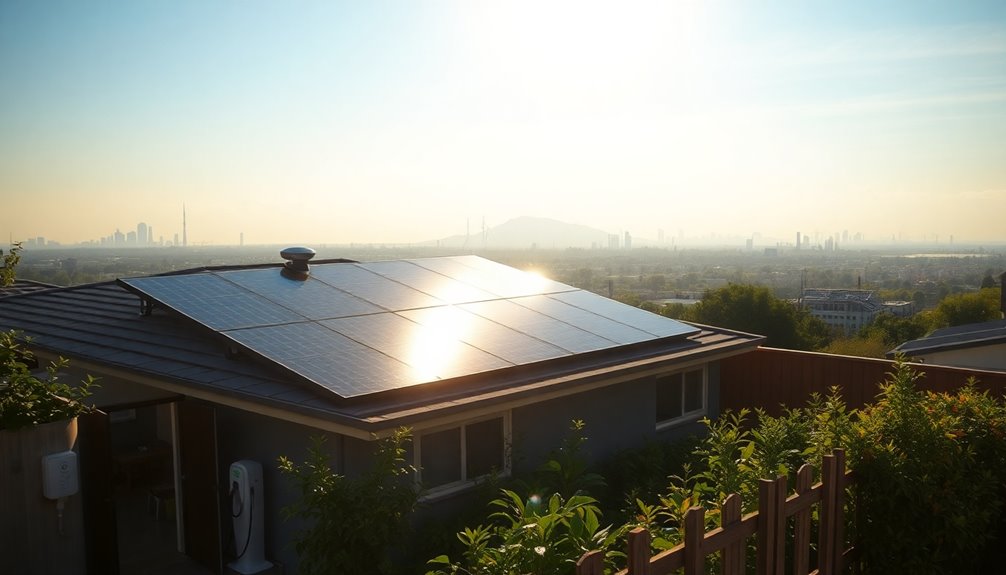
As renewable energy technologies advance, it's crucial to recognize the vulnerabilities tied to fossil fuel dependency. Recently, energy costs surged by 25%, putting a strain on your budget and highlighting how reliant we're on fossil fuels.
In 2019, the U.S. spent around $700 billion on petroleum, a staggering amount that underscores the financial burden of this dependency.
Natural gas prices have more than doubled, jumping from $2.05 to over $5.50 per million BTUs. This volatility reflects the unpredictable nature of fossil fuel markets, making your household expenses susceptible to sudden spikes.
Extreme weather events, like the February 2021 cold front in Texas, cut natural gas production by 50%, exposing the risks associated with over-relying on these energy sources.
With fossil fuels constituting about 75% of total energy expenditures, you're left vulnerable to fluctuations in global markets and geopolitical tensions.
Shifting to renewable energy can mitigate these risks, offering a more stable and sustainable solution. By reducing your fossil fuel dependency, you not only protect your finances but also contribute to combating climate change, securing a cleaner environment for future generations.
Making the Switch: A Guide
Making the switch to renewable energy can save you significant money while also benefiting the environment.
With installation costs dropping and various government incentives available, changing has never been easier.
In this guide, you'll learn about the financial benefits, available subsidies, and a simplified installation process.
Cost Savings Overview
Switching to renewable energy not only helps the environment but can also greatly reduce your household expenses.
By embracing renewable energy sources, you can enjoy significant cost savings while contributing to a sustainable future.
Here's a quick overview of the financial benefits you can expect:
- Annual Savings: Households can save approximately $500 each year due to lower energy costs and reduced reliance on volatile fossil fuel markets.
- Decreased Initial Investment: The cost of solar power has dropped by over 55% in the last five years, making solar panels more accessible and financially attractive.
- Heating Savings: Clean energy options, like electric heat pumps, can save you up to £1,330 annually compared to traditional heating systems.
- Stable Energy Prices: With the rise in renewable energy adoption, you can expect stable energy prices and lower utility costs over time.
Incentives and Subsidies Available
While enjoying the cost savings of renewable energy, it's also important to explore the various incentives and subsidies that can make the switch even more affordable. One of the standout options is the 26% federal tax credit for solar energy installations, which greatly reduces your upfront costs.
Many states and municipalities add to your savings by offering local incentives, including additional rebates or tax credits for investing in renewable energy.
If you're considering solar panels, leasing options let you enjoy lower monthly rates compared to traditional electricity bills, making renewable energy even more accessible.
In the UK, government grants of up to £5,000 for electric heat pumps provide a sustainable heating alternative, leading to considerable long-term savings.
Recent legislation, like the Inflation Reduction Act, has improved the economic viability of clean energy. This makes it financially attractive for homeowners like you to switch to renewable sources.
By taking advantage of these incentives and subsidies, you'll not only reduce your energy costs but also contribute to a greener planet.
Installation Process Simplified
Many homeowners find the process of shifting to renewable energy simpler than expected.
With providers like Inspire Clean Energy, you can enroll without interruptions to your utility service. The installation process is straightforward, and you'll still receive your bills from the same company.
Here's a simplified guide to help you make the switch:
- Research Providers: Compare different renewable energy providers to find one that suits your needs.
- Explore Incentives: Look into local incentives and the 26% federal tax credit for solar panel installations to cut down on costs.
- Choose Your System: Decide whether solar panels or electric heat pumps work best for your home's energy efficiency goals.
- Schedule Installation: Once you've made your choice, schedule the installation with qualified professionals who can guarantee everything is set up correctly.
Conclusion
Switching to renewable energy at home can feel like stepping into the future, much like the heroes of a sci-fi epic who embrace new worlds. While the initial investment might seem intimidating, the long-term savings can be substantial, as renewable costs continue to drop. By making this switch, you're not just saving money; you're safeguarding the planet for generations to come. So, why not take that leap and be part of the clean energy revolution today?

